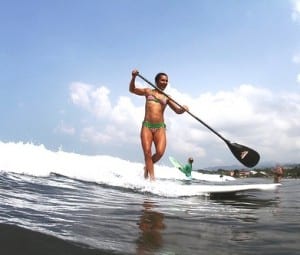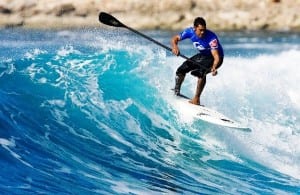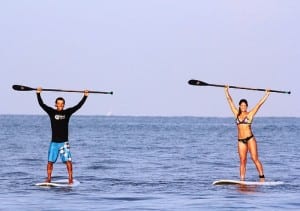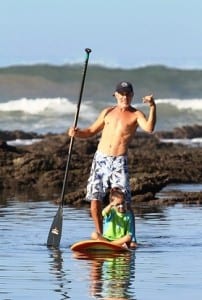What’s all the buzz about stand-up paddle surfing?
It’s one of the fastest emerging global water sports, that’s what.
Also called stand-up paddleboarding, or SUP for short, the sport is popular with surfers as a way to keep fit when surf is low and also as another way to catch waves. Because it is a great full-body workout, other athletes like skiers, snowboarders, etc. are using stand-up paddle surfing to cross train.
 Described as “walking on water,”it involves standing on a big, long modified surfboard and using a long paddle (like a one blade kayak paddle) to maneuver in the water. You use balance and the strength of your body “core” to stay up and move. Since you are standing at your full height, you get both a great look at the marine life below and clear views all around. You can discover new areas paddling far out past the surf line or explore calm bays and inlets; SUP also is popular on lakes and rivers.
Described as “walking on water,”it involves standing on a big, long modified surfboard and using a long paddle (like a one blade kayak paddle) to maneuver in the water. You use balance and the strength of your body “core” to stay up and move. Since you are standing at your full height, you get both a great look at the marine life below and clear views all around. You can discover new areas paddling far out past the surf line or explore calm bays and inlets; SUP also is popular on lakes and rivers.
Unlike regular wave surfers, using a stand-up paddleboard, you don’t have to wait for the right tides; you have the flexibility to go out at any tide and in most conditions. And if you want to ride waves, using your paddle helps you catch more waves than on a regular surfboard. Stand-up paddleboarding is very easy to learn. Within one hour you can become very comfortable in the water and on your board. SUP tends to be more popular with women, because with their lower center of gravity that makes it easier to balance, women are often more skilled at paddle boarding than men.
Stand up paddle boarding is actually an ancient form of surfing, originating like regular surfing in the Hawaiian Islands. In the early 1960s, the beach boys of Waikiki would stand on their long boards and paddle out with long outrigger paddles to take pictures of the tourists learning to surf. This is where the term "beach boy surfing," another name for stand-up paddle surfing, originates.
Surfing legends Laird Hamilton and Dave Kalama re-introduced the ancient sport to the modern water sports world several years ago. Nowadays, it is a huge industry with specialized stand-up paddleboard makers, companies selling SUP gear, agencies featuring SUP vacations, SUP teams and races and competitions. There is even an on-line Stand Up Paddle Surfing Magazine, www.SUPSurfMag.com. Other excellent sources of information on SUP include www.paddlesurfhawaii.com and www.rei.com/expertadvice/articles/paddleboarding.html.
SUP is popular in warm coastal areas around the globe. In Costa Rica, you benefit from warm water and terrific tropical weather. Del Mar Surf Camp in Hermosa Beach on Costa Rica’s Central Pacific Coast has two fantastic Stand Up Paddle Boarding packages– one for 4 days / 5 nights and the other for 6 days / 7 nights.
Designed for both men and women seeking adventure and surfers of all levels, the vacation packages’ theme is “Relax. Paddle. Discover the Ocean.” SUP instructors will teach you how to paddle out through the beach break, introduce you to different techniques of paddle boarding, and even show you how to catch some waves. Your days will be spent in conditioning and training classes to strengthen your core (Beach Boot Camp, Circuit Training, boxing, etc.), and going out on Stand Up Paddling tours. After each full day, Yoga or Pilates classes will enable you to stretch your muscles and practice your flexibility
All of Del Mar’s packages include top rated private or shared lodging close to the beach, and also near town. At the end of your week, Del Mar even treats you to a full body massage to rejuvenate your body before heading home. Check out their website for more information on the Stand Up Paddle Boarding vacations.
Del Mar Surf Camp specializes in surf vacation packages, yoga-surf retreats and day surf camps for kids, teens, adults, women only and families. They operate in three different spectacularly beautiful locations in Costa Rica – Hermosa Beach on the Central Pacific Coast just south of Jaco Beach, Nosara Beach on the northern Pacific Coast of Guanacaste, or Santa Teresa Beach on the Pacific’s Nicoya Peninsula.
By Shannon




Comments